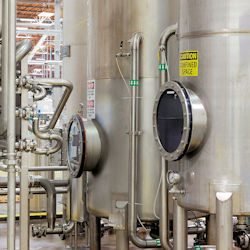Program Elements
Employers are required to have a permit-required confined space program (also called a permit space program) when they allow employees to enter confined spaces in their workplaces that meet the definition of a permit-required confined space and pose hazards to workers.
OSHA outlines required elements that must be included in a confined space program:
- Identification of confined spaces: Employers must identify all confined spaces in their workplace.
- Hazard evaluation: Employers must evaluate the potential hazards associated with each confined space.
- Written plan: Employers must develop and implement a written confined space plan that includes procedures for safe entry, ventilation, communication, emergency response, and rescue.
- Entry procedures: Employers must establish and implement safe entry procedures for each confined space.
- Training: Employers must train workers on the hazards and safety procedures associated with confined spaces.
- Rescue and emergency services: Employers must ensure that rescue and emergency services are available and trained in confined space rescue.
- Equipment: Employers must provide and maintain appropriate personal protective equipment and other equipment necessary for safe entry and rescue.
- Recordkeeping: Employers must maintain records of confined space evaluations, permits, training, and incidents.
The specific requirements for a confined space program may vary depending on the type and level of hazards associated with the confined spaces, and may also vary by jurisdiction.
1910.146(c)(4)
If employees will enter permit spaces, the employer must create and follow a written program. This must be available for inspection.
...
1910.146(d)
Permit-required confined space program (permit space program). Under the permit space program required by paragraph (c)(4), the employer must:
- 1910.146(d)(1) Implement steps to prevent unauthorized entry;
- 1910.146(d)(2) Identify and evaluate hazards of permit spaces before employees enter;
- 1910.146(d)(3) Develop and follow methods for safe entry, including:
- (i) Specifying acceptable entry conditions;
- (ii) Allowing authorized entrants or their reps to observe testing;
- (iii) Isolating the permit space;
- (iv) Purging, inerting, flushing, or ventilating the space to control hazards;
- (v) Providing barriers to protect from outside hazards;
- (vi) Verifying entry conditions remain acceptable during entry.
- 1910.146(d)(4) Provide and maintain needed equipment at no cost and make sure it is used properly:
- (i) Testing and monitoring equipment (per paragraph d(5));
- (ii) Ventilation equipment to reach safe conditions;
- (iii) Communication tools (per paragraphs h(3) and i(5));
- (iv) PPE where other controls are not enough;
- (v) Lighting for safe work and emergency exits;
- (vi) Barriers and shields (see d(3)(v));
- (vii) Equipment like ladders for safe entry and exit;
- (viii) Rescue equipment (unless provided by rescue services);
- (ix) Any other needed equipment for safe entry and rescue.
- 1910.146(d)(5) Evaluate conditions during entry:
- (i) Test for acceptable conditions before entry; monitor during work if space is large or continuous;
- (ii) Continue testing to keep safe conditions;
- (iii) Test first for oxygen, then flammable gases, then toxic gases;
- (iv) Allow entrants or reps to observe all testing;
- (v) Reevaluate if requested due to safety concerns;
- (vi) Share test results right away with entrants or their reps.
- Note: Testing done as in Appendix B (and E for sewers) is considered acceptable.
- 1910.146(d)(6) Provide at least one attendant outside the space during entry;
- Note: One attendant may monitor more than one space if they can perform duties safely and effectively.
- 1910.146(d)(7) If one attendant monitors multiple spaces, include methods to respond to emergencies without losing focus on duties;
- 1910.146(d)(8) Assign roles (entrants, attendants, supervisors, testers), list duties, and train each person as required by paragraph (g);
- 1910.146(d)(9) Plan for rescue, emergency help, and stop unauthorized rescue attempts;
- 1910.146(d)(10) Have a system for permits including how to issue, use, and cancel them;
- 1910.146(d)(11) Coordinate entries when more than one employer has workers inside to prevent harm to any worker;
- 1910.146(d)(12) Plan how to safely end the entry, like closing the space and canceling the permit;
- 1910.146(d)(13) Review the program when there’s reason to think it failed and fix problems before allowing more entries;
- Note: Review is required after events like unauthorized entry, new hazards, injuries, or employee complaints.
- 1910.146(d)(14) Review the program within one year using canceled permits. Update it if needed to keep workers safe.
- Note: One review per year is enough unless no entries happened that year.
- Appendix C gives examples of acceptable permit space programs.
...
1910.146(l)
Employee participation.
-
1910.146(l)(1)
Employers must consult with affected employees and their authorized representatives on developing and carrying out all parts of the permit space program required by paragraph (c).
-
1910.146(l)(2)
Employers must make all required information available to affected employees and their authorized representatives.
Knowledge Check Choose the best answer for the question.
2-1. The employer must develop and implement a written plan as part of the Confined Space Program if ______.
You forgot to answer the question!

